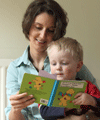June
From the mouths of babes – The truth about toddler talk

The sound of small children chattering has always been considered cute – but not particularly sophisticated. However, research by a Newcastle University expert has shown their speech is far more advanced than previously understood.
Dr Cristina Dye, a lecturer in child language development, found that two to three- year-olds are using grammar far sooner than expected.
She studied fifty French speaking youngsters aged between 23 and 37 months, capturing tens of thousands of their utterances.
Dr Dye, who carried out the research while at Cornell University in the United States, found that the children were using ‘little words’ which form the skeleton of sentences such as a, an, can, is, an, far sooner than previously thought.
Dr Dye and her team used advanced recording technology including highly sensitive microphones placed close to the children, to capture the precise sounds the children voiced. They spent years painstakingly analysing every minute sound made by the toddlers and the context in which it was produced.
They found a clear, yet previously undetected, pattern of sounds and puffs of air, which consistently replaced grammatical words in many of the children’s utterances.
Dr Dye said: “Many of the toddlers we studied made a small sound, a soft breath, or a pause, at exactly the place that a grammatical word would normally be uttered."
“The fact that this sound was always produced in the correct place in the sentence leads us to believe that young children are knowledgeable of grammatical words. They are far more sophisticated in their grammatical competence than we ever understood.
“Despite the fact the toddlers we studied were acquiring French, our findings are expected to extend to other languages. I believe we should give toddlers more credit – they’re much more amazing than we realised.”
For decades the prevailing view among developmental specialists has been that children’s early word combinations are devoid of grammatical words. On this view, children then undergo a ‘tadpole to frog’ transformation where due to an unknown mechanism, they start to develop grammar in their speech. Dye's results now challenge the old view.
Dr Dye said: “The research sheds light on a really important part of a child’s development. Language is one of the things that makes us human and understanding how we acquire it shows just how amazing children are.
“There are also implications for understanding language delay in children. When children don’t learn to speak normally it can lead to serious issues later in life. For example, those who have it are more likely to suffer from mental illness or be unemployed later in life. If we can understand what is ‘normal’ as early as possible then we can intervene sooner to help those children.”
Dr Dye is organsing the organising the Neuro-cognition of Developmental Disorders Affecting Language conference, which will be held in Newcastle on 9 July. Free places are available and for more information, email cristina.dye@newcastle.ac.uk.
Notes to editors
The research was originally published in the Journal of Linguistics
published on: 15 June 2013
